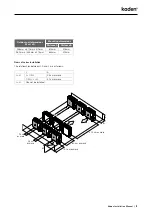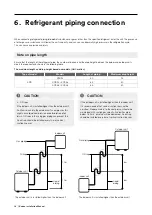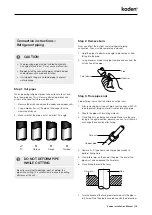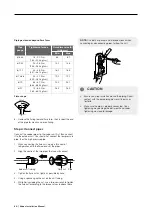
Kaden Installation Manual |
5
CAUTION
Do not
install the unit in a location that may be exposed to combustible gas leaks. If combustible gas accumulates around the
unit, it may cause fire.
Do not
operate your air conditioner in a wet room such as a bathroom or laundry room. Too much exposure to water can cause
electrical components to short circuit.
1. The product must be properly grounded at the time of installation, or electrical shock may occur.
2. Install drainage piping according to the instructions in this manual. Improper drainage may cause water damage to your
home and property.
ELECTRICAL WARNINGS
• Only fully qualified licensed personnel should install, service or carry out maintenance to this air conditioning unit.
All electrical work is to follow local and national wiring standards and the Installation Manual.
• The product must be properly grounded at the time of installation, or electrical shock may occur.
• For all electrical work, follow all local and national wiring standards, regulations, and the Installation Manual. Connect cables
tightly, and clamp them securely to prevent external forces from damaging the terminal. Improper electrical connections can
overheat and cause fire, and may also cause shock. All electrical connections must be made according to the Electrical
Connection Diagram located on the panels of the indoor and outdoor units.
• All wiring must be properly arranged to ensure that the control board cover can close properly. If the control board cover is
not closed properly, it can lead to corrosion and cause the connection points on the terminal to heat up, catch fire, or cause
electrical shock.
• If connecting power to fixed wiring, an all-pole disconnection device which has at least 3mm clearances in all poles, and
has a leakage current that may exceed 10mA, the residual current device (RCD) having a rated residual operating current
not exceeding 30mA, and disconnection must be incorporated in the fixed wiring in accordance with the wiring rules.
TAKE NOTE OF FUSE SPECIFICATIONS
The air conditioner’s circuit board (PCB) is designed with a fuse to provide overcurrent protection.
The specifications of the fuse are printed on the circuit board, such as:
Indoor unit:
T3.15A/250VAC, T5A/250VAC, etc.
Outdoor unit:
T20A/250VAC (7.0kW), T30A/250VAC (7.0kW)





































